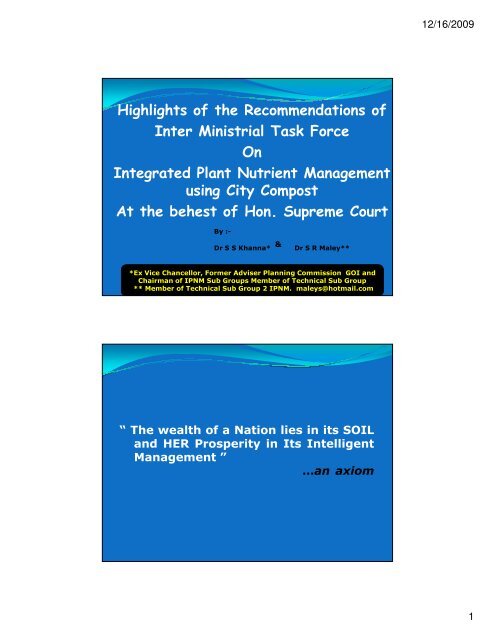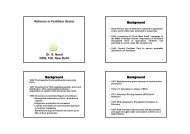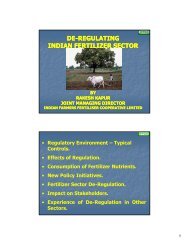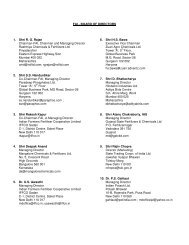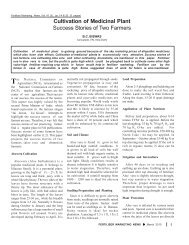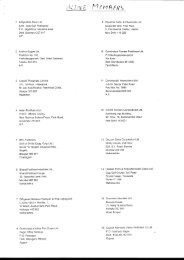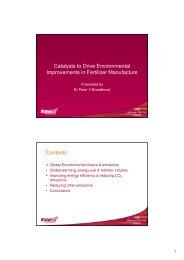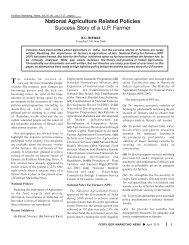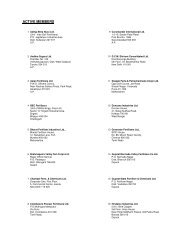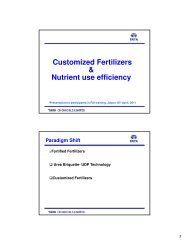Highlights of the Recommendations of Inter Ministrial Task Force On ...
Highlights of the Recommendations of Inter Ministrial Task Force On ...
Highlights of the Recommendations of Inter Ministrial Task Force On ...
You also want an ePaper? Increase the reach of your titles
YUMPU automatically turns print PDFs into web optimized ePapers that Google loves.
<strong>Highlights</strong> <strong>of</strong> <strong>the</strong> <strong>Recommendations</strong> <strong>of</strong><br />
<strong>Inter</strong> <strong>Ministrial</strong> <strong>Task</strong> <strong>Force</strong><br />
<strong>On</strong><br />
Integrated Plant Nutrient Management<br />
using City Compost<br />
At <strong>the</strong> behest <strong>of</strong> Hon. Supreme Court<br />
By :-<br />
Dr S S Khanna* & Dr S R Maley**<br />
*Ex Vice Chancellor, Former Adviser Planning Commission GOI and<br />
Chairman <strong>of</strong> IPNM Sub Groups Member <strong>of</strong> Technical Sub Group<br />
** Member <strong>of</strong> Technical Sub Group 2 IPNM. maleys@hotmail.com<br />
“ The wealth <strong>of</strong> a Nation lies in its SOIL<br />
and HER Prosperity in Its Intelligent<br />
Management ”<br />
…an axiom<br />
12/16/2009<br />
1
1. Ever increasing quantities <strong>of</strong> solid waste in Urban India is<br />
posing several challenges to city administration across <strong>the</strong><br />
country.<br />
2. Several issues relating to Municipal Solid Waste from planning<br />
to budgetary provisions and regulatory aspects remained least<br />
priority over several decades.<br />
3. The subject came into lime light following Surat – plague<br />
episode in September, 1994. With Planning Commission<br />
appointing High Power Committee (Dr. Bajaj Committee) and<br />
several initiative at State Government Level.<br />
4. As a consequent to poor state <strong>of</strong> Solid Waste Management in<br />
several cities PIL No 888 / 1996 was filed in <strong>the</strong> Supreme<br />
Court <strong>of</strong> India by Mrs. Almitra Patel & o<strong>the</strong>rs Vs Union <strong>of</strong> India<br />
and all States.<br />
5. Under this PIL Hon’ble Supreme Court has issued several<br />
directives and orders including appointment <strong>of</strong> Technical<br />
Committee (Barman Committee) to review critical aspects <strong>of</strong><br />
MSW in India. This became <strong>the</strong> basis for Rule making.<br />
6. This was followed by Gazette notification <strong>of</strong> Municipal Solid<br />
Waste (Management & Handling Rules 2000) by MOEF New<br />
Delhi on 25 th Sept 2000. This makes it mandatory for all ULB’s<br />
in India to systematize Solid Waste Management including<br />
setting up <strong>of</strong> Plants for Processing <strong>of</strong> MSW through Biocomposting,<br />
Vermi-composting, Anaerobic digestion etc.<br />
7. PIL 888/1996 still continues in <strong>the</strong> Supreme Court <strong>of</strong> India.<br />
The Hon’ble Court has fur<strong>the</strong>r directed The Government <strong>of</strong><br />
India to constitute <strong>Inter</strong> <strong>Ministrial</strong> <strong>Task</strong> force on Integrated<br />
Plant Nutrient Management by using city compost. This was<br />
with <strong>the</strong> objective <strong>of</strong> solving <strong>the</strong> problem <strong>of</strong> city waste faced by<br />
Urban Local Bodies and to raise <strong>the</strong> fertility <strong>of</strong> soil through<br />
IPNM.<br />
12/16/2009<br />
2
1. Affidavit was filed by <strong>the</strong> Union <strong>of</strong> India in Supreme Court on<br />
25-2-2003, regarding Constitution <strong>of</strong> <strong>Inter</strong> Ministerial <strong>Task</strong><br />
<strong>Force</strong> on IPNM using city compost. (Cabinet Secretariat<br />
meeting held on 12-2-2003, circulated vide No<br />
062/3/1/2003-CA IV <strong>of</strong> 26.2.03)<br />
2. The <strong>Task</strong> force was set up under <strong>the</strong> MOUD & PA, New Delhi<br />
with Jt. Secretary UD as chairman. And Experts & Sr. Officials<br />
from related Ministries and Departments, including Fertilizer<br />
Sector as members (Order No.Q-11021/1/2003 PHE II, dated<br />
26-03-2003)<br />
3. The TOR included preparation <strong>of</strong> Policy Strategy and Action<br />
Plan for promoting IPNM using city compost along with<br />
syn<strong>the</strong>tic fertilizers in every sector <strong>of</strong> Agriculture,<br />
Horticulture, Plantation crops, Forestry and rehabilitation <strong>of</strong><br />
mining areas.<br />
Sub Group 1:<br />
1. Appointment <strong>of</strong> Sub Group vide order No.-Q 11021/1/2003<br />
PHE II <strong>of</strong> 13/8/2003 with Dr.SS Khanna as chairman and 5<br />
o<strong>the</strong>r members.<br />
2. TOR was to study problems faced by Compost Plants, Quality<br />
issues, marketability, sustainability, sale price and O & M<br />
issues.<br />
3. 19 composting plants were visited and relevant data obtained<br />
for consideration in <strong>the</strong> new approach.<br />
12/16/2009<br />
3
Sub- Group 1:<br />
1. <strong>Inter</strong>ministerial <strong>Task</strong> <strong>Force</strong> on Integrated plant Nutrient Management using<br />
city Compost by G.O.I.<br />
2. Constitution <strong>of</strong> sub-group.<br />
i) Dr. S.S Khanna, Chairman Non-Official<br />
ii) Dr. PD Sharma, ADG,ICAR Official Member<br />
iii) Dr. AB Akolkar, Add. Director (PCP) (CPD) -do- -do-<br />
iv) Dr. NB Mazumdar, Chief(Projects),HUDCO -do- -do-<br />
v) Dr. N Tripathi, Add..Comm.(INM), Min. Agri. -do- -do-<br />
Terms <strong>of</strong> Reference:<br />
1. To study <strong>the</strong> problems/constraints faced by <strong>the</strong> Manufacturers<br />
/authorities in <strong>the</strong> functioning <strong>of</strong> Compost Plants<br />
2. Quality <strong>of</strong> Compost (organic manured) produced.<br />
3. Its Marketability.<br />
4. Plant Engineering/Mechanical failures.<br />
5. Operations and Maintenance to sizing <strong>of</strong> Plant.<br />
6. Sale price <strong>of</strong> Compost , sustainability & o<strong>the</strong> constraints<br />
12/16/2009<br />
4
Combined Report<br />
� The combined report <strong>of</strong> <strong>Task</strong> <strong>Force</strong><br />
and Sub Groups based on <strong>the</strong><br />
availability <strong>of</strong> biodegradable<br />
component <strong>of</strong> <strong>the</strong> garbage & total<br />
class 1 city waste <strong>of</strong> about 50 m MT<br />
was submitted to <strong>the</strong> Urban<br />
Development Ministry in May 2005 for<br />
onward submission to <strong>the</strong> Supreme<br />
Court.<br />
<strong>Recommendations</strong> <strong>of</strong> <strong>Task</strong> <strong>Force</strong><br />
concerning <strong>the</strong> Fertilizer Sector:<br />
1. Co-marketing <strong>of</strong> compost from city waste with chemical<br />
fertilizers by Fertilizer Companies as basket approach should be<br />
mandatory.<br />
2. Co-marketing <strong>of</strong> compost with chemical fertilizers in <strong>the</strong> ratio<br />
<strong>of</strong>- 3 to 4 bags: 6 to 7 bags (Compost Fertilizer)<br />
3. The Fertilizer companies have to market whatever quantities<br />
are made available to <strong>the</strong>m.<br />
4. Formulation <strong>of</strong> Proper Compost standards, Grades, Testing and<br />
Regulatory Provisions by Ministry <strong>of</strong> Agriculture. The Agri.<br />
Ministry has notified standards for Compost in March 2006,<br />
which have been revised now. (The revised Standards are under<br />
notification in Oct ’09)<br />
5. Transportation subsidy to Fertilizer companies or <strong>the</strong>ir<br />
warehousing agents @ Rs150/-MT (Budget Pr.<strong>of</strong>Rs60.00 Cr.)<br />
6. Capital Subsidy <strong>of</strong> Rs700/-Cr for Compost Plant establishment<br />
(This is being taken care by MOUD & PA) under <strong>the</strong> JNNURM,<br />
UIDSSMT and TFC Schemes.<br />
7. Awareness and demonstration for Compost usership by Agril.<br />
Ministry (Budget <strong>of</strong> Rs 40.00 Cr)<br />
12/16/2009<br />
5
Supreme Court Order:<br />
1 st September 2006, Hon’ble Supreme Court issued order<br />
(1.A.No18) endorsing <strong>the</strong> recommendations <strong>of</strong> <strong>the</strong> <strong>Task</strong> <strong>Force</strong><br />
with immediate effect.<br />
Gist <strong>of</strong> <strong>the</strong> Court order is as following:<br />
“The <strong>Inter</strong>-Ministerial <strong>Task</strong> <strong>Force</strong> on Integrated Plant Nutrient<br />
Management had submitted its report and recommendations in<br />
May 2005. The order dated 1 st September 2006 notes <strong>the</strong><br />
submission <strong>of</strong> Mr. Rao on behalf <strong>of</strong> Union <strong>of</strong> India that a short<br />
adjournment may be granted so that he could discuss <strong>the</strong> matter<br />
with o<strong>the</strong>r Ministries like Ministry <strong>of</strong> chemicals and Fertilizers.<br />
Nothing has been placed on record objecting to <strong>the</strong><br />
recommendations <strong>of</strong> <strong>the</strong> report. Under <strong>the</strong>se circumstances, we<br />
direct <strong>the</strong> implementation <strong>of</strong> <strong>the</strong> recommendations in <strong>the</strong> report<br />
with immediate effect. The Government is , however, given<br />
liberty to approach this Court, if any genuine difficulty is faced in<br />
implementation <strong>of</strong> any <strong>of</strong> <strong>the</strong> recommendations.”<br />
Agriculture Ministry’s affidavit regarding Compost usership as per<br />
Supreme court order DO No. 3436/02/SC/PIL dated: 23.01.2003)<br />
is as following:<br />
The Affidavit was filed through Director General <strong>of</strong> ICAR which<br />
mentions following:<br />
1. There is no denying <strong>the</strong> fact that Integrated Plant Nutrient<br />
Management is a novel practice <strong>of</strong> fertilizer use for sustaining<br />
soil health and crop productivity. It has been amply<br />
demonstrated by <strong>the</strong> All India Coordinated Long Term Fertility<br />
Project <strong>of</strong> ICAR, that integrated use <strong>of</strong> optimal dose <strong>of</strong> NPK<br />
and FYM [Farm Yard Manure] ensures better and sustainable<br />
yields, while correcting some <strong>of</strong> <strong>the</strong> micro and secondary<br />
nutrient deficiencies.<br />
2. We are still short <strong>of</strong> organic manures to practice IPNM on a<br />
large scale.<br />
12/16/2009<br />
6
3. The supplies could be augmented to a great extent, especially<br />
in pre-urban areas, by recycling and composting <strong>of</strong> huge<br />
biodegradable city waste. Height proportion <strong>of</strong> plastic matter<br />
in <strong>the</strong> city waste is creating problem during handling for<br />
composting.<br />
4. The composting <strong>of</strong> city waste would serve <strong>the</strong> twin objective<br />
<strong>of</strong> cleaning <strong>the</strong> cities and replenishing <strong>the</strong> soils with <strong>the</strong> much<br />
needed humus rich in nutrients and moderating soil<br />
environment.<br />
5. The city composts should be cost-effective and ensure<br />
organic and inorganic toxic elements and contaminants<br />
within safer limits for large scale use on farmers’ fields. The<br />
produce raised on city compost should be monitored for <strong>the</strong><br />
quality for few years, before allowing use <strong>of</strong> compost on a<br />
wider scale.<br />
6. The Government should encourage setting up <strong>of</strong> city waste<br />
compost plants to clean <strong>the</strong> cities and environment on costly<br />
fertilizer input and <strong>the</strong>reby, reduce <strong>the</strong> cost <strong>of</strong> cultivation and<br />
maintain long term soil health and productivity.<br />
General<br />
Concern’s<br />
Urban solid waste management is an essential social services for<br />
protection <strong>of</strong> environment and health <strong>of</strong> <strong>the</strong> citizen.<br />
Therefore, least cost, most appropriate technological option for<br />
<strong>the</strong> safe and scientific management should receive <strong>the</strong> due and<br />
needed attention, funding, support, help and guidance at all level.<br />
Central and State Governments, Municipalities, Industries and<br />
Institutions, Non–Governmental Organization and Individual<br />
citizens should all cooperate for securing safe management <strong>of</strong><br />
solid urban wastes.<br />
From Indian Cities S.U.W has low calorific value and high<br />
moisture content with low percentage <strong>of</strong> combustible material,<br />
hence is generally unsuitable for <strong>the</strong>rmal technology.<br />
12/16/2009<br />
7
Issue<br />
(a) The National Agriculture Policy envisages annual growth <strong>of</strong> 4%<br />
in agricultural production<br />
(b) The Country would need 30/ M mt <strong>of</strong> food grain by 2025 to<br />
feed 1.4 billion population. This would required 35 M mt <strong>of</strong><br />
chemical fertilizer nutrient basis, as against 19.4 M mt at<br />
present.<br />
(c) Continuous use <strong>of</strong> high analysis chemical fertilizer over <strong>the</strong><br />
years and neglect <strong>of</strong> organic manures have resulted into large<br />
scale deficiency <strong>of</strong> not only major but also secondary and micro<br />
plant & nutrients (such as S, Mm, Fe,Zn &B) .<br />
Swaminathan(1992) has summed up <strong>the</strong> nutrient supply options<br />
relevant to Indian conditions. According to him “Soil <strong>of</strong> India are<br />
<strong>of</strong>ten not only thirsty but also hungry” .Inputs are needed for<br />
output. Therefore , what we need is a reduction in <strong>the</strong> use <strong>of</strong><br />
market purchased chemical input and not <strong>of</strong> input per se. It is in<br />
this context that integrated system <strong>of</strong> nutrient supply suitable for<br />
easy adoption include crop rotations, green manure and bi<strong>of</strong>ertilizers,<br />
bi-dynamic systems that makes significant use <strong>of</strong><br />
Compost & humus will help to improve soil structure & fertility.<br />
Points to Ponder<br />
In India where <strong>the</strong> land –person ratio is rapidly declining , <strong>the</strong><br />
only means <strong>of</strong> meeting <strong>the</strong> need <strong>of</strong> agriculture produce is through<br />
increased productivity without detrimental to environment &<br />
sustainability. The per capita land availability in <strong>the</strong> country has<br />
decreased from 0.48 ha in 1951 to 0.17 ha in 1985 is projected to<br />
be fur<strong>the</strong>r reduced to 0.10 ha by <strong>the</strong> year 2005. In successful<br />
management <strong>of</strong> soil quality , fertility & productivity, following<br />
related aspects need fur<strong>the</strong>r consideration:-<br />
1. Optimum and balanced utilization <strong>of</strong> all plant nutrient sources<br />
through Integrated nutrient management.<br />
2. Application <strong>of</strong> nutrient & keeping in view <strong>the</strong> cropping system ,<br />
genotype & characteristic <strong>of</strong> plants.<br />
3. System-approach-keeping in view <strong>the</strong> lithosphere,<br />
hydrosphere and atmosphere into consideration.<br />
12/16/2009<br />
8
Parameter Unit (% or value)<br />
1. Moisture content 40 to 50%<br />
2. Organic matter 30 to 35%<br />
3. Nitrogen 0.5 to 0.6%<br />
4. Phosphorus 0.5 to 0.6%<br />
5. Potassium 0.5 to 0.6%<br />
6. Calcium 0.44 to 0.55%<br />
7. Magnesium 0.24 to 034%<br />
8. Sulphates 0.35 to 0.45%<br />
9. Carbon 15 to 20%<br />
10. pH value 6.5 to 7.5%<br />
11. C/N ratio 25 to 30<br />
Compost Technology<br />
Most modern technology developed by <strong>the</strong> Indian Scientists<br />
/Engineers & O<strong>the</strong>rs Involves two stages:-<br />
1. Waste Sanitization treatment:- Herbal sanitizer removes foul smell<br />
ills pathogens and hinders spread <strong>of</strong> diseases through germs, flies ,<br />
mosquitoes & o<strong>the</strong>r disease vectors.<br />
2 Inoculant:- Using microbial culture having a mixture <strong>of</strong> mesophillic ,<br />
<strong>the</strong>rmophilic micro-organisms identified to be highly effective in speedy<br />
decomposition <strong>of</strong> bio-degradable segment <strong>of</strong> garbage, particularly<br />
lignin, carbohydrates (cellulous, hemi-celluloses etc) , protein , waxes &<br />
fats.<br />
3. Composting:- During <strong>the</strong> process <strong>of</strong> Composting <strong>the</strong> organic residues<br />
<strong>of</strong> plant and animal origin are rapidly converted by <strong>the</strong> microbe under<br />
aerobic water and moist conditions into organic manure which is rich in<br />
HUMUS. The moisture is maintained at 40-60 % and temperature at 60-<br />
70 degree Celsius.<br />
12/16/2009<br />
9
4. Processing:-<br />
i) After controlled aerobic Composting by <strong>the</strong> specific microbes <strong>the</strong><br />
decomposed material is passed through mechanical rotary screen <strong>of</strong><br />
different sizes 40 mm, 32 mm, 25mm, 8mm and 4mm sieves.<br />
ii) The enrichment <strong>of</strong> organic manure is conducted with different bifertilizers<br />
, major and micronutrients (if required depending upon <strong>the</strong><br />
soil test value , cropping system and agro-ecological conditions)<br />
iii) Thereafter weighing , bagging , stitching and stacking is performed<br />
iv) For keeping <strong>the</strong> required population <strong>of</strong> beneficial microbes alive 17-20<br />
% moisture is necessary.<br />
All this well depicted in Flow Chart and Platform<br />
diagram.<br />
Composition <strong>of</strong> organic manure ,produced from city wastes<br />
A. Physical : Dark Brown in colour<br />
Moisture 17%<br />
B. Biological: Rich in total bacteria: (10 10 ) come Actinomycetes, fungi,<br />
Azotobacter, phosphate solubilizing bacterial ,<br />
Nitrobacter etc.<br />
C. Chemical :<br />
pH 6.5 to 8.2<br />
Organic carbon 12%<br />
Nitrogen 1.0 to 1.5<br />
Total Phosphorus 0.5 to 0.8%<br />
Potassium 0.5 to 0.8%<br />
Calcium 2.0 to 3.0%<br />
Magnesium 0.5 to 0.75%<br />
Sulphates 0.4%<br />
Fe 0.6%<br />
Zn 300 to 700 ppm<br />
Mn 250 to 740 ppm<br />
Cu 200 to 375 ppm<br />
Could vary depending upon <strong>the</strong> source <strong>of</strong> waste<br />
12/16/2009<br />
10
12/16/2009<br />
11
Evaluation <strong>of</strong> Phospo- Sulpho-Nitro Compost<br />
under different Cropping Systems<br />
Treatment Soybean wheat Sorghum wheat<br />
Control 6.55 13.29 13.30 6.67<br />
75% NPK 8.00 23.84 27.58 16.14<br />
100%NPK 8.76 28.12 31.53 17.80<br />
75%NPK 10.12 32.84 34.90 24.42<br />
+Compost<br />
Soybean +<br />
wheat<br />
sorghum<br />
11.59<br />
9.28<br />
17.68<br />
22.50<br />
22.96<br />
27.94<br />
2810<br />
32.10<br />
Source:- Manna M.C et al. Indian Institute <strong>of</strong> Soil Science (ICAR),<br />
Bhopal, PP 11 Bulletin No. 02/2006<br />
Economic advantages <strong>of</strong> Phosphor-Sulfo-Nitro compost<br />
• In a three years field study on soybean-wheat system, application <strong>of</strong> 100 % NPK through<br />
enriched compost to soybean and 50% NPK to success ding wheat produced <strong>the</strong> highest<br />
yield and saved 25 kg N and 39.2 kg P/ha.<br />
• A five years field study on vertisols revealed that compost application @ 5 t ha in<br />
combination with 75% NPK to soybean applied to wheat produced higher productivity in<br />
soybean-wheat, sorghum-wheat, and soybean sorghum –wheat system compared to 100%<br />
NPK treatment and saved 37 kg N.30 kg P and 15kg K.<br />
• To improve soil biological activities phosphor-sulpho- Nitro compost along with chemical<br />
fertilizer application is <strong>the</strong> best option compared to inorganic fertilizer alone. The use <strong>of</strong><br />
enriched manure in field crops is also economically viable and safe to <strong>the</strong> environment.<br />
12/16/2009<br />
12
Action Points for <strong>the</strong> promotion and<br />
functioning <strong>of</strong> Compost Plants<br />
1. Central Government.<br />
Ministry <strong>of</strong> Agriculture :<br />
(a) Capital subsidy for installation <strong>of</strong> Compost Plants.<br />
(b) Transport subsidy on sale <strong>of</strong> finished product.<br />
(c ) Massive awareness generation programme.<br />
(d) Guidelines for use <strong>of</strong> city garbage –lab to land.<br />
(d) Horticultural crops, high value low volume crops.<br />
(f) R&D and promotion activity <strong>of</strong> Rs 40 Cr.<br />
(g) ICAR & SAUs should institute special projects as “ Lab to<br />
Land” National Demonstration program <strong>of</strong> INM on various<br />
crops using quality city compost..<br />
Ministry Urban Development and poverty<br />
alleviation:<br />
(a) Study <strong>of</strong> Appropriate Design and Standardization <strong>of</strong> city garbage<br />
management.<br />
(b) To release all directions in <strong>the</strong> proper management <strong>of</strong> SWM to<br />
ULBS<br />
(c) To coordinate all activities at <strong>the</strong> Govt. <strong>of</strong> India Ministries level<br />
and also advise State Govts. for <strong>the</strong> proper management <strong>of</strong> SUW<br />
and running efficiently <strong>the</strong> compost plants<br />
Plant Size Cost <strong>of</strong> Compost Plant (<br />
Rs. In Lakhs)<br />
Subsidy Grant (Rs. In<br />
Lakhs)<br />
50 187.2 56.2<br />
100 294.7 88.4<br />
200 508.9 152.7<br />
300 654.7 196.4<br />
500 918.7 275.6<br />
12/16/2009<br />
13
Ministry <strong>of</strong> Finance<br />
• Tax holiday for 10 years.<br />
• No excise and custom duty on Plant and Machinery.<br />
• Directive to buy back <strong>the</strong> composted manure.<br />
• <strong>Inter</strong>est subsidy for lending loan to financial institutions.<br />
• The capitalization <strong>of</strong> interest subsidy.<br />
• No import duty for vital equipment and technology<br />
Ministry Of Mines<br />
Compulsory application <strong>of</strong> composted manure in degraded<br />
land, mining spoil and a forestation.<br />
Ministry <strong>of</strong> Railways<br />
Use <strong>of</strong> city compost for plantation /a forestation <strong>of</strong> land<br />
around <strong>the</strong> railway line and stations.<br />
Chemical Fertilizer Companies<br />
Shall provide co-marketing facilities to <strong>the</strong> compost sector as a<br />
long term business strategy. Co- marketing should be made<br />
mandatory within 100-150 Kms. <strong>of</strong> radius <strong>of</strong> any city compost<br />
plant as a BASKET Approach. However to ensure compost<br />
marketability, and transport subsidy to <strong>the</strong> tune <strong>of</strong> 150/MT and<br />
manufacturing subsidy <strong>of</strong> Rs 350/ MT Respectively <strong>of</strong> <strong>the</strong><br />
finished product . Taxes shall not be levied by <strong>the</strong> Central, state<br />
government & ULB’S.<br />
Ministry <strong>of</strong> environment and forest<br />
(a) Quality control standard<br />
(b) Use <strong>of</strong> Compost for rehabilitation <strong>of</strong> degraded land, mining<br />
spoils dumps etc.<br />
(c) Landfill preparation and <strong>the</strong>ir ultimate management<br />
12/16/2009<br />
14
2. State Govts.<br />
(a) Specific and strict compliance <strong>of</strong> <strong>the</strong> SWM directives <strong>of</strong> Hon.<br />
Supreme Court and G.O.I<br />
(b) Basket deal directive to fertilizer dealers.<br />
(c) Enrichment requirement <strong>of</strong> Compost Plant based on cropping<br />
system and agro-ecological conditions.<br />
(d) No sale tax and local (toll tax) taxes on manure produced<br />
from compost plants.<br />
Municipality (ULB)<br />
(a) No royalty from <strong>the</strong> Compost Plant (s)<br />
(b) Extending all <strong>the</strong> required/Unstinted support, help and<br />
guidance for <strong>the</strong> proper functioning <strong>of</strong> <strong>the</strong> compost plants.<br />
(c) Buy back arrangement <strong>of</strong> <strong>the</strong> manure produced from <strong>the</strong>re<br />
compost plants. Treating this project as <strong>the</strong>ir own and<br />
supply <strong>the</strong> well segregated biodegradable garbage /<br />
material to <strong>the</strong>se compost plant and supply electricity<br />
/water as for agriculture sector.<br />
12/16/2009<br />
15
1. Latest estimates for 100 cities generating above 300 MT/day<br />
– MSW indicates availability <strong>of</strong> 5.38million tone <strong>of</strong> Compost<br />
per annum within next 3 to 4 years.<br />
2. In 63 cities, covered under JNNURM, Composting plants may<br />
start Production within next 18 to 24 months, as <strong>the</strong><br />
financial sanctions are accorded to most <strong>of</strong> <strong>the</strong>se cities.<br />
3. Recently, New Government at Center has added 35 more<br />
cities under <strong>the</strong> above scheme<br />
4. In <strong>the</strong> immediate future plants established/ nearing<br />
commissioning/ under installation in: Kochi, Chennai,<br />
Madurai, Coimbatore, Puducherry, Bangalore, Hyderabad,<br />
Mumbai, Navi Mumbai, Thane, Mira-Bhayandar, Nagpur,<br />
Surat, Vadodara, Indore, Kanpur, Agra, Faridabad, Amritsar<br />
etc. etc. will be able to Provide good quality Compost for<br />
coming Kharif & Rabi Seasons.<br />
New city composting projects under<br />
implementations:<br />
1 Amritsar 9 Mumbai 17 Bangalore<br />
2 Faridabad 10 Navi Mumbai 18 Chennai<br />
3 Kanpur 11 Thane 19 Coimbatore<br />
4 Meerut 12 Chandigarh 20 Madurai<br />
5 Varanasi 13 Pune 21 Haridwar<br />
6 Agra 14 Surat 22 Kochi<br />
7 Indore 15 Varodra 23 Puducherry<br />
8 Nagpur 16 Rajkot 24 New Delhi<br />
Implementations Companies<br />
1 a2z Infrastructure (3, 4,5,6)<br />
2 UFlex –hanzer biotech (2,3,8,11,16,21)<br />
3 Ramky enviro engineers (17,24)<br />
4 Hydro air Tectonics (10,18)<br />
5 United Phosphorus (9,19)<br />
12/16/2009<br />
16
Kanpur Site Success Story<br />
holistic approach<br />
Available<br />
Primary responsibility<br />
What to do<br />
Door to door<br />
collection<br />
Collectio<br />
n &<br />
Transpor<br />
tation<br />
Transfer<br />
stations<br />
1450 TPD<br />
garbage<br />
Secondary<br />
transportatio<br />
n to<br />
processing<br />
facility<br />
Processing<br />
to produce:<br />
Organic<br />
fertilizer,<br />
green coal,<br />
building<br />
blocks etc<br />
Compost quality – highly superior because <strong>of</strong> segregated garbage<br />
Meets <strong>the</strong> standard specification <strong>of</strong> GOI <strong>of</strong> Nov 3rd<br />
Conclussion<br />
Processing<br />
& Disposal<br />
Sanitary<br />
Engineered<br />
landfill<br />
� Recent researches have revealed that conjunctive<br />
application <strong>of</strong> inorganic fertilizers and organic<br />
manures is a must for sustainable production system in<br />
terms <strong>of</strong> soil quality and pr<strong>of</strong>itability .<br />
� The time is ripe when concerned efforts are made to<br />
harness all sources <strong>of</strong> biodegradable segment <strong>of</strong> farm<br />
and city wastes.<br />
� The integrated plant and nutrient system(IPNS)<br />
approach is being regarded as <strong>the</strong> only solution to this<br />
problem.<br />
12/16/2009<br />
17
� The govt. <strong>of</strong> India at <strong>the</strong> behest <strong>of</strong> Hon. Supreme Court<br />
has issued certain directions such as co-marketing<br />
,basket approach and has also granted financial<br />
incentives which should be implemented by all<br />
stakeholders ,in particular fertilizers companies, state<br />
govt. and urban local bodies.<br />
� The fertilizer companies, dealers and market outlet<br />
should come forward for co marketing and basket<br />
approach for INM approach<br />
� Adopting this approach would keep cities clean, green,<br />
sustainable agriculture,<br />
Have thy faith firm,<br />
<strong>the</strong> day will dawn.<br />
Gurudev Rabindra Nath Tagore<br />
12/16/2009<br />
18
Reference<br />
� Annual reports 2007 and 2008-2009.Indian institute <strong>of</strong> soil science (ICAR) Bhopal<br />
� CPCB 2000 status <strong>of</strong> municipal solid waste generation ,collection, treatment and disposal<br />
in class I cities ,central pollution board ,Ministry <strong>of</strong> Environmental & Forests, Govt. <strong>of</strong><br />
India New Delhi.<br />
� Hargreaves,J.C adl MS warman ,P.R 2008.A review <strong>of</strong> <strong>the</strong> use <strong>of</strong> composted municipal solid<br />
waste in agriculture, ecosystem and environment 123,1-14.<br />
� <strong>Inter</strong>ministerial task force on integrated plant nutrient management ,may<br />
2005,constituted by ministry <strong>of</strong> urban development govt. <strong>of</strong> India ,New Delhi.<br />
� Kumar S. Bhattacharya ,J.V ,Vaidya A.M Chakraborty ,T,Devolta ,S Akolkar ,A.B 2009<br />
.Assessment <strong>of</strong> <strong>the</strong> status <strong>of</strong> municipal solid waste management in metro cities ,state<br />
capital, class I cities and class II towns <strong>of</strong> India ,an insight waste management 29,883-<br />
895.<br />
� Manna M.C Tripathi,A.B Singh 2007.Phospho-sulpho nitro compost Utapadan abang<br />
mulyankan Tech. bulletin 1:IISS ,Bhopal ,PP1-11.<br />
� S.Shareholy M.Ahmed ,K ,Mehmood G,Trivedi ,R.C 2008 .municipal solid waste<br />
management in Indian cities –a review waste management.28,459-467.<br />
� The Gazette <strong>of</strong> India, Ministry <strong>of</strong> environment and forest, notifications N0648 Oct 3<br />
2000.<br />
� The Gazette <strong>of</strong> India, Ministry <strong>of</strong> agriculture and co-operation, notification march<br />
2006(revised one in press Oct 2009)<br />
12/16/2009<br />
19


